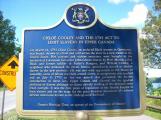1
"Standing Up For Freedom"James A. Black, M.Ed
As citizens of Canada, we take for granted many of the rights and priviledges to which we have grown accustomed. Historically, we have in fact ignored many of our unsung and unrecognised heroes. With little or no notice, some individuals have stood up for and drawn our attention to a social wrong that needs to be fixed. Such a person was Peter Martin, by all accounts associated with Butler's Rangers, attached to the military unit of the British Empire stationed at Fort George in Niagara-on-the-Lake, Ontario.
2
Fort Mississauga, National Historic Site, believed to have been built by Coloured Corps22 June 2009
Niagara-on-the-Lake, Ontario, Canada
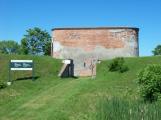 Credits:
Credits:James Black
3
During the 1790's, John Graves Simcoe, first Lt. Governor of Upper Canada, transferred many British laws to Canada including; legalised marriages, the civil law system of Great Britain and our court system. Unlike Great Britain, Upper Canada supported the practise of keeping human property or slaves. Simcoe found slavery incomprehensible and proposed the abolition (removal) of it from Upper Canada. He received considerable opposition from slave owners. Simcoe struck a deal with the slave owners who sat on the government by phasing out slavery over many years and forbidding the importation of any more slaves into Canada. Wealthy citizens of Upper Canada could therefore keep their free nannies, house keepers, child and adult labour, while at the same time agreeing to the abolition of the ownership of human beings as property.4
Statue of Governor John Graves Simcoe, a well-known Mason22 June 2009
Niagara-on-the-Lake, Ontario, Canada
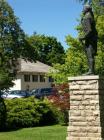 Credits:
Credits:James Black
5
Peter Martin, in service to Butler (of Butler's Rangers) stationed at Fort George, was caught in a unique position. He was told that a farmer by the name of William Fromonds who lived near by (in what is present day Virgil, Ontario) had planned on tying up a young teenager named Chloe Cooley who was in his service and forcibly taking her to the United States to sell her into American Slavery. Fromond carried out his plan, aided by his brother and another culprit by the name of Venevry. A witness to the event by the name of Grisley, recounted how the young girl had "screamed violently and made resistance" as she was dragged to the shore of the Niagara River and pushed into a small boat. She was taken to a waiting slave trader on the eastern side of the Niagara River. On that American side of the river, she was forced off the boat close to where another man was similarly bound with ropes.7
Under the New Government, Governor Simcoe had done his best to abolish Slavery but his proposed anti-slavery laws did not foresee the export of slaves. Fromond had found a loophole to make money from selling human beings to the United States. While a workman's yearly income in the 1790's was the equivalent of a couple of hundred dollars a year, the sale of a slave could could bring in as much as the equivalent of $200 and go as high as $1,200 dollars per slave. Fromond, his brother and their accomplice Venevry made a substantial income for a day in dealing in human flesh.8
Approximate Location of the Transportation of Chloe Cooley to American Slavery22 June 2009
Niagara-on-the-Lake, Ontario, Canada
 Credits:
Credits:James Black
9
On March 21, 1793, Peter Martin apparently asked for and received an audience with the Executive Council of Upper Canada including: His Excellency John Graves Simcoe, Honourable William Osgoode Chief Justice and the Honourable Peter Russell. Unlike the full sitting council who sat at the Freemason Lodge in Newark (Niagara-on-the-Lake) the Executive Council met at Navy Hall. As a lowly member of the military establishment, Martin was making a presentation to the most powerful people in Upper Canada. After the presentation the council passed a resolution --"RESOLVED: that it is necessary to take immediate steps to prevent the continuance of such violent breaches of the public peace, and that for that purpose that His Majesty's Attorney General be forthwith directed to prosecute the said Fromond."
10
Reconstruction of Masonic Lodge on Original Location22 June 2009
Niagara-on-the-Lake, Ontario, Canada
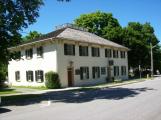 Credits:
Credits:James Black
11
It is surprising that Peter Martin, a black servant ('in service'), would be able to persuade the highest level of the government of Upper Canada to actually be concerned with a black girl from Upper Canada being sold into American slavery. Even more surprising may be the fact that Peter Martin would have felt at home in the Coloured Corps of Butlers Rangers and if captured during the War of Independence could have been sold into slavery himself.12
Acknowledgement of the Coloured Corps20 July 2009
Queenston Heights Park, Ontario, Canada
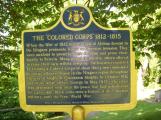 Credits:
Credits:James Black
13
At Fort George, the Freemason military lodges were attended to by many of the soldiers who served their respected governments. At Newark (now Niagara-on-the-Lake) the local non-military Freemasons' built a lodge which served the community as a church, legislative assembly, and meeting place. As a fraternal organization each member was treated with equal respect and concern. In the military lodges officers left their rank at the door, so to speak. Had Martin been a member of the Lodge he would have been welcomed as a member of the "craft." There is no indication that Martin was a member of the Masons. However; Simcoe was an outstanding member who was regarded by another historic figure Joseph Brant as "humane, sensible and honest." Such personal comments suggest Brant had much personal contact with Simcoe at the Mason Lodge. Peter Martin may have become aware of Simcoe's approachability as a member of the military Mason Lodge or by his reputation among the members of the military who had personal contact with him.14
Bertie Hall, Masonic Style House - safe house for Freedom Seekers22 June 2009
Fort Erie, Ontario, Canada
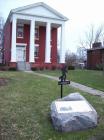 Credits:
Credits:James Black
